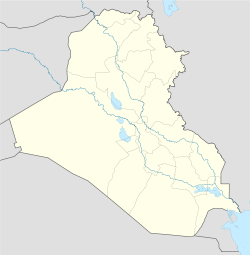- Marad
-
For other uses, see Marad (disambiguation).
Coordinates: 32°04′N 44°47′E / 32.067°N 44.783°E
Marad (Sumerian: Marda, modern Tell Wannat es-Sadum or Tell as-Sadoum, Iraq) [1] was an ancient Sumerian city. Marad was situated on the west bank of the then western branch of the Upper Euphrates River west of Nippur in modern day Iraq and roughly 50 km southeast of Kish, on the Arahtu River.
Marad Location in Iraq Coordinates: 32°04′00″N 44°47′00″E / 32.0666667°N 44.7833333°E The city's ziggurat E-igi-kalama [2] was dedicated to Ninurta the god of earth and the plow, built by one of Naram-Sin's sons, as well as the tutelary deity Lugalmarada (also Lugal-Amarda).[3] The city fell into the bounds of the Akkadian empire after the conquest of Sargon of Akkad.
Contents
History
Marad was established ca. 2700 BC, during the Sumerian Early Dynastic II period.
Archaeology
The site of Marad covers an area of less than 124 hectares (500 acres).
Marad was excavated by a team from Qādisiyyah University in 1990 led by Naal Hannoon, and in 2005 and 2007 led by Abbas Al-Hussainy.[4] Publication of the last two seasons is in progress.
Notes
- ^ Sumerian City-States
- ^ Dalley, Stephanie (1998) Myths from Mesopotamia: Creation, the flood, Gilgamesh, and others. Oxford University Press ISBN 0192835890 p324
- ^ sumerian gods
- ^ Naal Hannoon, N/A, Sumer, vol. 49, pp. N/A, 2000
References
- FS Safar, Old Babylonian contracts from Marad, University of Chicago,1938
See also
Categories:- Sumerian cities
- Akkadian cities
- Archaeological sites in Iraq
- Former populated places in Iraq
- Ancient Near East stubs
- Near East archaeology stubs
- Iraq geography stubs
Wikimedia Foundation. 2010.

